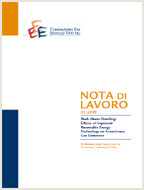Constitutions and Social Networks

Date
22.06.2015
22.06.2015
Authors
Ana Mauleon (CEREC – Saint Louis University, CORE – University of Louvanin); Nils Roehl (University of Paderborn, Bielefeld University); Vincent Vannetelbosch (CORE – University of Louvanin, CEREC – Saint Louis University)
JEL Code
C72, C78, D85
C72, C78, D85
Keywords:
Social Networks, Constitutions, Stability, Many-to-Many Matchings
Social Networks, Constitutions, Stability, Many-to-Many Matchings
Publisher
Climate Change and Sustainable Development
Climate Change and Sustainable Development
Editor
Calro Carraro
Calro Carraro
The objective of the paper is to analyze the formation of social networks where individuals are allowed to engage in several groups at the same time. These group structures are interpreted here as social networks. Each group is supposed to have specific rules or constitutions governing which members may join or leave it. Given these constitutions, we consider a social network to be stable if no group is modified any more. We provide requirements on constitutions and players’ preferences under which stable social networks are induced for sure. Furthermore, by embedding many-to-many matchings into our setting, we apply our model to job markets with labor unions. To some extent the unions may provide job guarantees and, therefore, have influence on the stability of the job market.
***
Suggested citation: Mauleon, A., N. Roehl, V. Vannetelbosch, (2015), ‘Constitutions and Social Networks’, Nota di Lavoro 59.2015, Milan, Italy: Fondazione Eni Enrico Mattei
